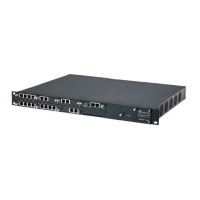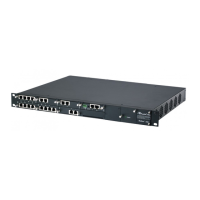CHAPTER19 Coders and Profiles
Mediant 800 Gateway & E-SBC | User's Manual
Parameter Description
'RTCP Mode'
sbc-rtcp-mode
[IPProfile_SBCRTCPMode]
Defines how the device handles RTCP packets during call
sessions for the SIP entity associated with the IP Profile.
This is useful for interworking RTCP between SIP entities.
For example, this may be necessary when incoming RTCP
is not compatible with the destination SIP entity's (this IP
Profile) RTCP support. In such a scenario, the device can
generate the RTCP and send it to the SIP entity.
■ [0] Transparent = (Default) RTCP is forwarded as is
(unless transcoding is done, in which case, the device
generates RTCP on both legs).
■ [1] Generate Always = Generates RTCP packets
during active and inactive (e.g., during call hold) RTP
periods (i.e., media is 'a=recvonly' or 'a=inactive' in the
INVITE SDP).
■ [2] Generate only if RTP Active = Generates RTCP
packets only during active RTP periods. In other words,
the device does not generate RTCP when there is no
RTP traffic (such as when a call is on hold).
Note: The corresponding global parameter is
SBCRTCPMode.
'Jitter Compensation'
sbc-jitter-compensation
[IpProfile_
SBCJitterCompensation]
Enables the on-demand jitter buffer for SBC calls. The jitter
buffer can be used when other functionality such as voice
transcoding are not done on the call. The jitter buffer is
useful when incoming packets are received at inconsistent
intervals (i.e., packet delay variation). The jitter buffer
stores the packets and sends them out at a constant rate
(according to the coder's settings).
■ [0] Disable (default)
■ [1] Enable
Note:
■ The jitter buffer parameters, 'Dynamic Jitter Buffer
Minimum Delay' (DJBufMinDelay) and 'Dynamic Jitter
Buffer Optimization Factor' (DJBufOptFactor) can be
used to configure minimum packet delay only when
transcoding is employed.
■ This functionality may require DSP resources. For
more information, contact the sales representative of
your purchased device.
'ICE Mode'
ice-mode
[IPProfile_SBCIceMode]
Enables Interactive Connectivity Establishment (ICE) Lite
for the SIP entity associated with the IP Profile. ICE is a
methodology for NAT traversal, employing the Session
Traversal Utilities for NAT (STUN) and Traversal Using
Relays around NAT (TURN) protocols to provide a peer
with a public IP address and port that can be used to
connect to a remote peer.
■ [0] Disable (default)
■ [1] Lite
For more information on ICE Lite, see ICE Lite.
- 431 -

